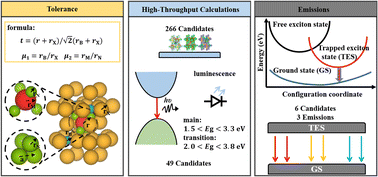Eco-friendly inorganic molecular novel antiperovskites for light-emitting application†
Abstract
The development of perovskite light-emitting diodes (PeLEDs) has progressed rapidly over the past several years, with high external quantum efficiencies exceeding 20%. However, the deployment of PeLEDs in commercial devices still faces severe challenges, such as environmental pollution, instability and low photoluminescence quantum yields (PLQYs). In this work, we perform high-throughput calculations to exhaustively search the unexplored and eco-friendly novel antiperovskite space (formula: X3B[MN4], with octahedron [BX6] and tetrahedron [MN4]). The novel antiperovskites have a unique structure whereby a tetrahedron can be embedded into an octahedral skeleton as a light-emitting center causing a space confinement effect, leading to the characteristics of a low-dimensional electronic structure, which then makes these materials potential light-emitting material candidates with a high PLQY and light-emitting stability. Under the guidance of newly derived tolerance, octahedral, and tetrahedral factors, 266 stable candidates are successfully screened out from 6320 compounds. Moreover, the antiperovskite materials Ba3I0.5F0.5(SbS4), Ca3O(SnO4), Ba3F0.5I0.5(InSe4), Ba3O0.5S0.5(ZrS4), Ca3O(TiO4), and Rb3Cl0.5I0.5(ZnI4) possess an appropriate bandgap, thermodynamic and kinetic stability, and excellent electronic and optical properties, making them promising light-emitting materials.

- This article is part of the themed collection: New horizons in materials for energy conversion, optics and electronics


 Please wait while we load your content...
Please wait while we load your content...